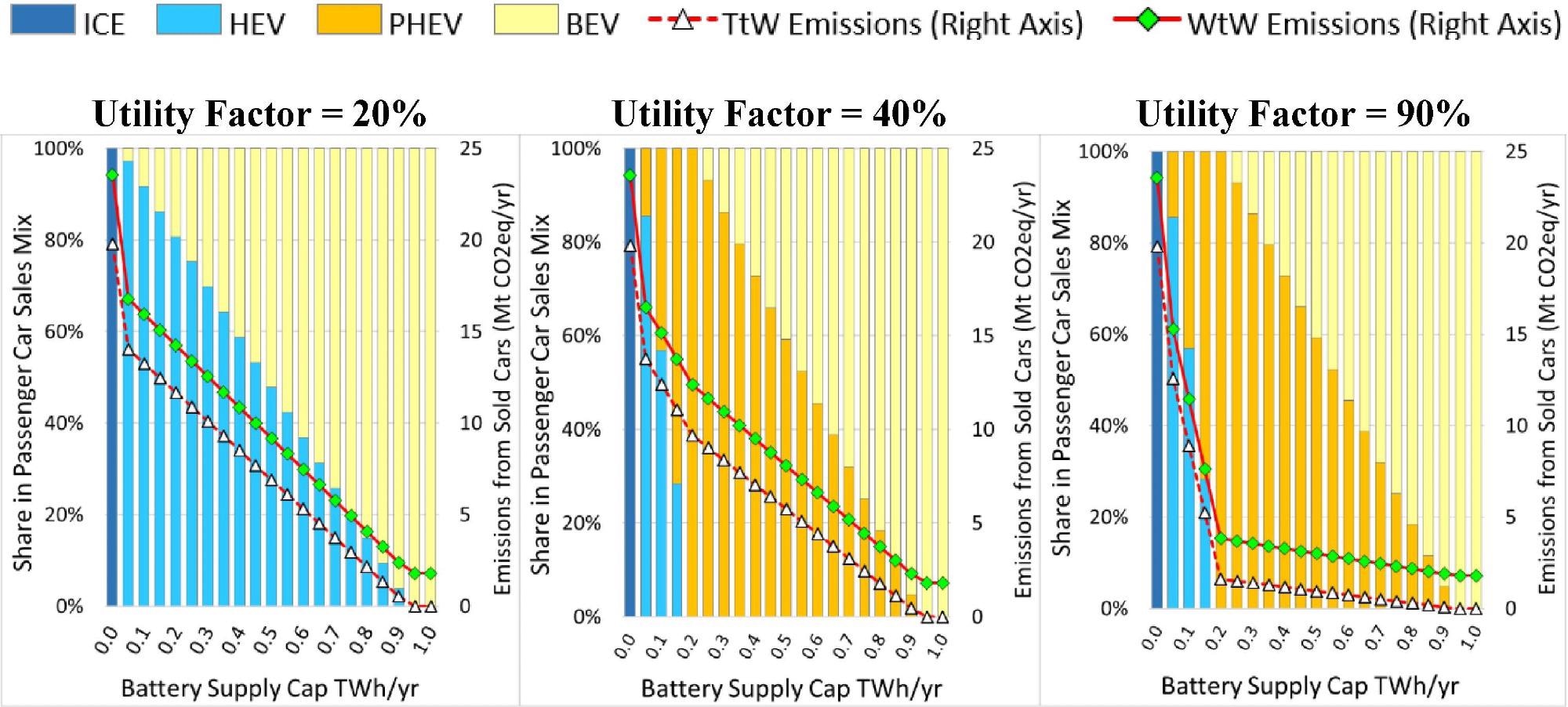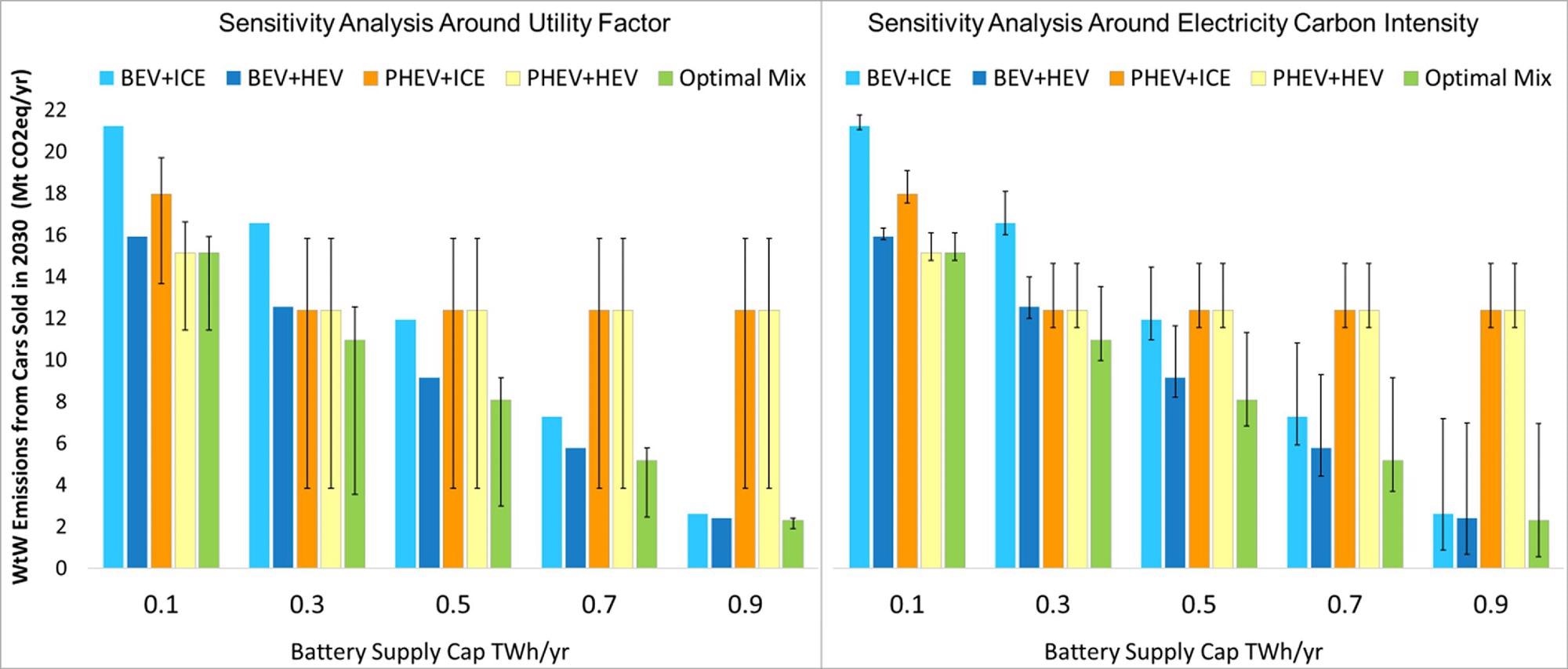In a study recently published in the journal Transportation Research Part D: Transport and Environment, researchers from Belgium forecasted the optimal sales mix of different powertrain vehicles in the European Union (EU) to minimize greenhouse gas (GHG) emissions from passenger cars between 2020-2030.

Study: Optimal electrification level of passenger cars in Europe in a battery-constrained future. Image Credit: All About Space/Shutterstock.com
This study also takes the EU-specific battery-constrained environment during the same period into consideration with linear and non-linear programming models.
GHG Emissions Forecast and Passenger Cars
The EU has set the goal of a 55% cut in GHG emissions by 2030 compared to its 1990 value. This has pushed many researchers to study its feasibility, constraints, and implications in the passenger car sector.
Currently, passenger cars come in various powertrain technologies with several emission reduction standards; mostly these are fossil fuel, electric, or hybrid-based. However, within the constraint of technology, availability of fuels and batteries, consumer demand, and government policies, an average powertrain mix forecast for the 2020–2030-time frame is fallible. The present demand is for an optimization of the sales mix.

Optimal vehicle sales mix minimizing WTW GHG emissions subject to battery supply cap in 2030 with break-even point being 30% — Baseline results assuming fixed battery sizes of 1.54 kWh (HEV), 12.5 kWh (PHEV-60), and 58.4 kWh (BEV-400). Image Credit: Shafiei, E et al., Transport and Environment
Many studies have taken life-cycle assessment (LCA) analysis to compare different vehicle technologies in terms of gCO2 eq/km or tons of CO2 eq along the whole lifetime of the vehicle and conclude that battery electric vehicles (BEVs) emit less GHG than internal combustion engine vehicles (ICEVs), hybrid electric vehicles (HEVs), and plug-in hybrid vehicles (PHEVs).
However, the PHEVs have smaller batteries than the BEVs, which significantly reduces GHG emissions over the vehicle life cycle, but homologation measurements could lead to an overestimation of the real-world utility factor (UF).
About the Study
This study presumed well-to-wheels (WTW) GHG emissions rather than tank-to-wheel (TTW) GHG emissions for passenger cars with different categories of battery production capacity. The WTW emissions assumed that the GHG emissions were not affected by the composition of vehicle sales, all batteries produced were fully allotted to the EVs without any wastage, and the emissions for all the non-battery-based vehicles were the same.
Moreover, it considered the battery-constrained environment, in which it was expected that the EU would not be able to keep pace with the growing demand for batteries due to visible constraints on both production capacity and raw material availability till 2030.
Additionally, the analysts adopted two different frameworks to evaluate the efficacy of different EV configurations with a constraint of different battery supply cap. First, a linear programming model was inducted to determine optimal vehicle sales mix by minimizing WTW GHG emissions under a limited battery supply cap with fixed battery size.
Later, the model was extended to a non-linear optimization model to evaluate optimal vehicle sales mix and battery size by minimizing WTW GHG emissions under the same constraints.

Impact of total sales volume on the optimal allocation of battery resources to different xEVs in 2030 — under the fixed baseline battery size assumption and the utility factors above 30%. Image Credit: Shafiei, E et al., Transport and Environment
What Were the Findings?
From the linear optimization model, it was evident that the UF of PHEVs is pivotal for the optimal sales mix and GHG emissions. For a given value of battery size and energy consumption for PHEVs, the UF is dependent on the behaviors of consumers, thus a sensitivity analysis was conducted to estimate the minimum/ break-even UF necessary to keep the relevance of PHEVs in the future sales mix.
The results showed that for PHEVs, the optimized break-even UF increased with an increase in battery size, whereas for BEVs, optimized break-even UF decreased with an increase in battery size. Also, the degree of sensitivity increased when PHEVs were assumed to have larger battery sizes comparable to that of BEVs.
Moreover, the sensitivity analysis concerning the range of the vehicle revealed that longer-range PHEVs could contribute to efficient WTW emissions reduction only if they are utilized with an above-average utility factor, otherwise HEV+BEV are superior.
Also, the analysis on hydrotreated vegetable oil (HVO) shares indicated that the optimal sales mix does not differ under different BEV range and utility factor categories. However, it contributes to a lower level of emissions compared to emissions from the similar sales mix in the baseline condition.
Additionally, by increasing the optimal level of electrification, the fuel-cycle emissions showed decreasing patterns, but the vehicle-cycle emissions increased with the level of electrification along with the flexible battery supply cap.

Comparison of minimized WTW GHG emissions subject to battery supply cap in different sales mix scenarios (left chart: error bars show the sensitivities with respect to utility factor ranging from 20% to 90%; right chart: error bars show the sensitivities with respect to the carbon intensity of electricity supply mix ranging from 0 to 76.4 gCO2eq/MJ). Image Credit: Shafiei, E et al., Transport and Environment
Conclusions
This study tried to forecast optimized sales mix of several powertrains viz. ICEVs, BEVs, HEVs, and PHEVs to meet the set goal of 55% emission reduction for the EU by 2030. The authors considered many constraint factors, namely, battery supply and production cap, UF, size of the battery, range of vehicle, availability of fuel, and energy consumption, which were not included in the previous studies.
PHEVs showed some promising results compared to others in a specific range of the above-mentioned parameters. The findings give an insight into the potential role of PHEVs in decarbonizing the road transport sector. The researchers suggested exploring the impact of influential factors in the context of a comprehensive LCA.
Reference
Shafiei, E., Dauphin, R., Yugo, M., Optimal electrification level of passenger cars in Europe in a battery-constrained future, Transportation Research Part D: Transport and Environment, Volume 102, 2022, 103132, ISSN 1361-9209, https://www.sciencedirect.com/science/article/pii/S1361920921004272
Disclaimer: The views expressed here are those of the author expressed in their private capacity and do not necessarily represent the views of AZoM.com Limited T/A AZoNetwork the owner and operator of this website. This disclaimer forms part of the Terms and conditions of use of this website.